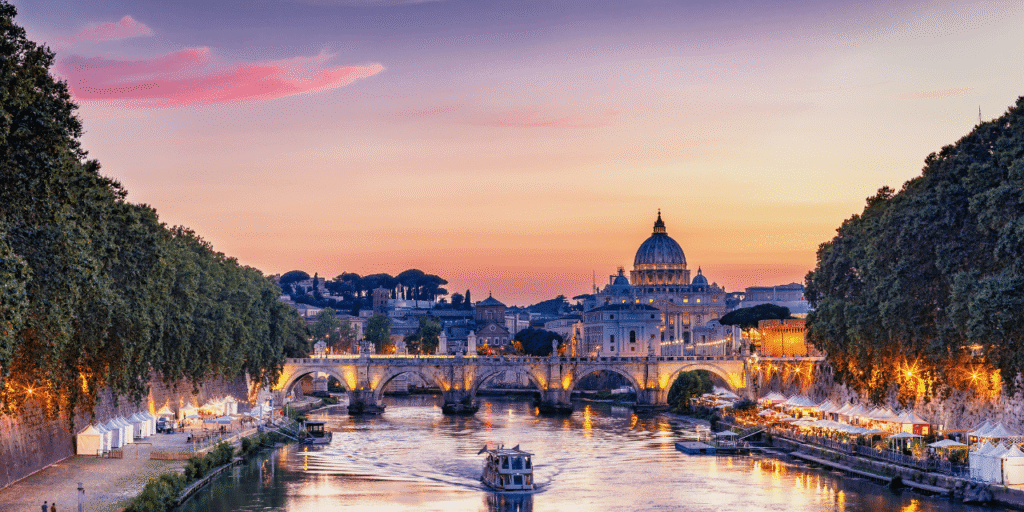Roughly 2 million people flock to Aruba annually to enjoy its picture-perfect beaches, clear turquoi...
Travel Guides
Figuring out how many days to spend in Rome helps you make the most of your trip. Whether you’re there for just a couple of days or a week, planning ahead ensures you see what matters most to you.


If you're wondering how many days to stay in Rome, most people find that 3 to 5 days is enough to see the main sights. However, extending your stay allows for a more relaxed pace and the chance to explore hidden gems.
This article shares detailed 1-day, 3-day, and 7-day itineraries to help you make the most of your time in Rome, whether you have just a day or a week.
Rome, the Eternal City, is a treasure trove of history, art, and culture. Its ancient ruins tell stories of a powerful empire, while its exquisite churches, piazzas, and fountains showcase centuries of artistic mastery.
Wandering through its streets feels like walking through a living museum, where every corner reveals a piece of the city’s rich past.
The city's lively neighborhoods, delicious food, and timeless charm create an atmosphere that captivates and inspires every visitor.
If your time is limited, you can still experience some of Rome’s most iconic sights by focusing on the essentials.
Start your day early at the Colosseum, then walk through the Roman Forum and Palatine Hill to immerse yourself in ancient history.
Roman Colosseum
From there, head to the Pantheon and enjoy a leisurely walk around Piazza Navona and the Jewish Ghetto.
Later, visit St. Peter’s Basilica or Castel Sant’Angelo for spectacular views and ambiance.
Finish with dinner in Trastevere or Campo de’ Fiori. Perfect for cruise stops, day trips, or travelers on a tight schedule, this route emphasizes walkability and quick visits to highlights.
Three days offer a perfect blend of main sights, cultural experiences, and local flavor at a more relaxed pace.
Start your day early at the Colosseum, exploring both the interior and the exterior. Afterwards, walk through the Roman Forum and Palatine Hill, taking your time to absorb the ancient history.
Roman Forum
In the afternoon, head to the Pantheon, then stroll around Piazza Navona and Campo de’ Fiori.
Finish your day with a visit to Trevi Fountain and the Spanish Steps, enjoying a leisurely dinner in nearby neighborhoods like Monti or Trastevere.
Spend your morning immersed in the Vatican. Visit St. Peter’s Basilica, climb to the dome for scenic city views, and tour the Vatican Museums, including the Sistine Chapel.
Afterward, relax in the charming Borgo Pio neighborhood or take a peaceful walk in St. Peter’s Square.
In the evening, explore the picturesque Ponte Sant’Angelo at sunset or enjoy a relaxed dinner at a local trattoria.
Dedicate this day to exploring Rome’s lively neighborhoods outside the main tourist hubs.
Head to Trastevere and explore its charming, narrow cobblestone streets. Stop by Santa Maria in Trastevere and indulge in an authentic Italian lunch.
In the afternoon, visit Villa Doria Pamphili or Janiculum Hill for panoramic views over the city. Alternatively, spend time in Testaccio for its lively food markets and authentic Roman cuisine.
Wrap up your trip with a relaxing evening at a rooftop bar or a quiet stroll along the Tiber River.
Make this sound better: A week gives you plenty of time to experience a true taste of Rome — beyond just the main sights. With a relaxed pace, you can enjoy the city without feeling rushed and soak in all its charm.
Here’s a day-by-day plan for a memorable week in Rome:
Start your Roman journey with the Colosseum, Roman Forum, and Palatine Hill. Walk through the ancient ruins and enjoy scenic views from Capitoline Hill and Piazza del Campidoglio.
Finish your day with a stroll along the Tiber River and dinner in Trastevere.
Spend the morning exploring Vatican City. Visit St. Peter’s Basilica, climb to the dome, and tour the Vatican Museums and Sistine Chapel.
In the afternoon, relax at Borgo Pio or take a walk along the Tiber.
In the evening, head to the Castel Sant'Angelo area. Take a leisurely walk along the river and admire the beautifully illuminated fortress. Finish your evening with a visit to a gelateria for some authentic Italian gelato—a perfect sweet ending to a memorable day.
Visit the Pantheon, Piazza Navona, and Campo de’ Fiori. Walk around the historic Pantheon area.
Then, make your way to Piazza di Spagna and the iconic Spanish Steps, and finish the afternoon at the Trevi Fountain, when the crowds are more manageable.
Trevi Fountain
In the evening, enjoy a local wine and cheese tasting or a dinner in Pigneto, Rome’s bohemian district.
Discover the charming Trastevere neighborhood. Wander its narrow streets, visit Santa Maria in Trastevere, and enjoy a long lunch or dinner at a traditional trattoria.
In the late afternoon, visit Villa Doria Pamphili for a peaceful outdoor break.
After visiting Villa Doria Pamphili, unwind with a stylish evening at a rooftop bar. Consider Terrazza Monti or the terrace at Hotel Minerva, both offering stunning city views.
Take a day trip to Tivoli, where you’ll explore the stunning Villa d’Este, renowned for its spectacular fountains and beautiful gardens.
Afterwards, visit Hadrian’s Villa, the sprawling ruins of Emperor Hadrian’s lavish retreat.
Wander through lush gardens, marvel at the ancient architecture, and soak in the serene beauty.
In the evening, return to Rome for a relaxed dinner near your hotel or in a lively neighborhood like Monti, reflecting on a day filled with history and natural beauty.
Dedicate this day to exploring Rome’s vibrant districts. Start in San Lorenzo, a trendy area known for its street art, markets, and youthful energy.
Wander through Villa Borghese and visit the Galleria Borghese to admire incredible art collections.
In the evening, head to Pigneto or Prati for relaxed bars, local street food, and authentic Roman nightlife.
Visit the Testaccio neighborhood, renowned for its authentic food markets and lively atmosphere, or relax in Parco degli Acquedotti — an ancient aqueduct park perfect for a peaceful walk.
Finish your trip with a sunset at Gianicolo Terrace or enjoy drinks at a rooftop bar overlooking the city skyline.
Want to keep your devices powered without worries? Check out our guide on Italy plug types so you're prepared for every socket.
The best time to visit Rome is during spring (April to June) and fall (September to November), when the weather is mild and crowds are smaller.
Summer (July and August) is lively, with festivals and outdoor events, but it can be very hot and crowded. Winter (December to February) offers a quieter, cozier atmosphere — ideal for museum visits and holiday celebrations.
For uninterrupted connectivity during your trip, consider purchasing an Italy eSIM in advance. This way, you can easily navigate the city, access travel apps, and share your experience without worry.
See also: Best time to visit Italy
Is 4 full days in Rome enough?
Yes, 4 full days in Rome are generally enough to explore major attractions like the Colosseum, Vatican City, and the Pantheon. You'll also have time to enjoy local neighborhoods and cuisines.
How long does it take to see the Vatican?
To thoroughly explore Vatican City, including St. Peter’s Basilica, the Vatican Museums, and the Sistine Chapel, you'll need about half a day to a full day. Arriving early can help you avoid crowds and make the most of your visit.
Where to stay in Rome for the first time?
For first-time visitors, areas like Monti, Trastevere, and the historic center (Centro Storico) are ideal. These neighborhoods offer a mix of proximity to major sights, excellent dining options, and a charming atmosphere.
Is Rome a walkable city?
Yes, Rome is very walkable, especially in the historic city center where many landmarks are close together. Comfortable walking shoes are essential to navigate its cobblestone streets and hilly terrain.
What is the rainiest month in Rome?
November is typically the rainiest month in Rome. It’s advisable to carry an umbrella or raincoat during your visit in autumn.
What's the cheapest month to go to Rome?
January and February are usually the cheapest months to visit Rome, as they fall in the low season. You can find better deals on flights and accommodations, and experience fewer crowds, although it will be cooler and less lively than other seasons.

